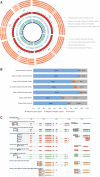Unlocking Triticeae genomics to sustainably feed the future
- PMID: 24204022
- PMCID: PMC3856857
- DOI: 10.1093/pcp/pct163
Unlocking Triticeae genomics to sustainably feed the future
Abstract
The tribe Triticeae includes the major crops wheat and barley. Within the last few years, the whole genomes of four Triticeae species-barley, wheat, Tausch's goatgrass (Aegilops tauschii) and wild einkorn wheat (Triticum urartu)-have been sequenced. The availability of these genomic resources for Triticeae plants and innovative analytical applications using next-generation sequencing technologies are helping to revitalize our approaches in genetic work and to accelerate improvement of the Triticeae crops. Comparative genomics and integration of genomic resources from Triticeae plants and the model grass Brachypodium distachyon are aiding the discovery of new genes and functional analyses of genes in Triticeae crops. Innovative approaches and tools such as analysis of next-generation populations, evolutionary genomics and systems approaches with mathematical modeling are new strategies that will help us discover alleles for adaptive traits to future agronomic environments. In this review, we provide an update on genomic tools for use with Triticeae plants and Brachypodium and describe emerging approaches toward crop improvements in Triticeae.
Keywords: Barley; Brachypodium; Crop improvement; Next-generation sequencing; Triticeae; Wheat.
Figures



References
-
- Alexandratos N, Bruinsma J. World Agriculture Towards 2030/2050: The 2012 Revision. 2012 ESA Working paper No. 12.03.
-
- Araki R, Murata J, Murata Y. A novel barley yellow stripe 1-like transporter (HvYSL2) localized to the root endodermis transports metal–phytosiderophore complexes. Plant Cell Physiol. 2011;52:1931–1940. - PubMed
Publication types
MeSH terms
LinkOut - more resources
Full Text Sources
Other Literature Sources

